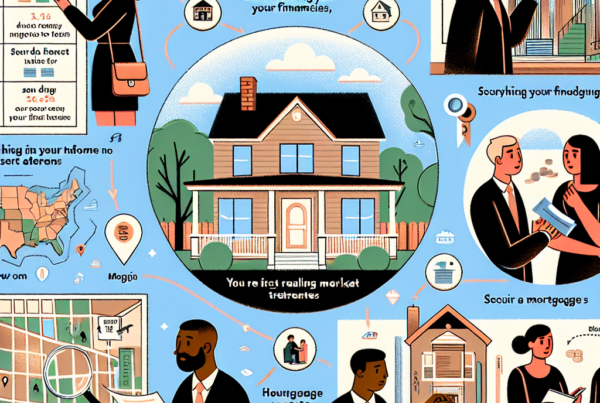Unlock the secrets of adjustable-rate mortgages with this comprehensive guide, revealing the pros and cons of these flexible home loans.
Table of Contents
Do you know what an adjustable-rate mortgage is? This is a special kind of home loan that can be pretty tricky to understand. In this blog post, we will dive into the adjustable-rate mortgage pros and cons. It’s really important to know about these pros and cons of adjustable-rate mortgage if you’re thinking about buying a home or just want to learn more about how money can work when getting a loan.
An adjustable-rate mortgage (often called an ARM) can be different from a regular loan called a fixed-rate mortgage. With a fixed-rate mortgage, the interest rate stays the same throughout the loan, but with an ARM, the rate can change. This can mean your monthly payment might go up or down! Understanding these details will help you make smart choices. So let’s get started on our adventure to learn about what an adjustable-rate mortgage is and why knowing its pros and cons is super important!
What is an Adjustable-Rate Mortgage (ARM)?
Definition of ARM
An adjustable-rate mortgage, or ARM, is a type of home loan where the interest rate can change over time. At first, this rate is usually lower than in other types of loans. But later, it might go up or down based on the market. This means your monthly payments could also change depending on what happens to the rate.
How ARMs Work
ARMs work a little differently than fixed-rate mortgages. With an ARM, you start with a special low interest rate for a certain period, often for a few years. After this period, the rate can adjust based on specific rules. These adjustments happen at regular times, like every year or every few years. Sometimes the rates can go up, making your monthly payments higher. Other times, they might go down, which could lower your payments.
Comparison to Fixed-Rate Mortgages
Fixed-rate mortgages are a bit easier to understand. With these loans, the interest rate stays the same for the whole time you have the mortgage. This means you know exactly how much you will pay every month. In contrast, with adjustable-rate mortgages, the rate and payments can change. So, choosing between these two types depends on if you prefer steady payments or if you’re okay with some ups and downs in what you pay each month.
Pros of Adjustable-Rate Mortgages
When you think about adjustable-rate mortgages, or ARMs, it’s good to know what makes them special. There are several pros of adjustable-rate mortgage options that many people find appealing. Understanding these can help you decide if an ARM is right for you.
Lower Initial Interest Rates
One of the best things about an adjustable-rate mortgage is that they usually start with lower rates compared to fixed-rate mortgages. This means that when you first get your loan, the amount of interest you pay is less. This can save you money right away!
Potential for Lower Payments
Because these lower interest rates help keep your payments small at the beginning, many people enjoy lower monthly payments when they have an ARM. This can be a great relief, especially for new homeowners who might be trying to budget their money. These smaller payments can make it easier to afford your home while you get settled in.
Possible Decrease in Rates
Another pro of adjustable-rate mortgages is that there’s a chance the interest rates could go down in the future. If the rates drop, your monthly payments could also go down. This means you might save even more money over time if rates stay low, making it easier to manage your expenses.
Understanding the pros and cons of adjustable-rate mortgage options is important. It can help you choose the best type of mortgage for your home. Knowing what’s good about ARMs lets you make a smart decision when it comes time to buy a home.
Cons of Adjustable-Rate Mortgages
When thinking about an adjustable-rate mortgage, or ARM, it’s important to know not just the good parts but also the cons of adjustable-rate mortgage options. Here are a few things to consider before deciding if an ARM is right for you.
Rate Increases
One of the biggest concerns with adjustable-rate mortgages is that your interest rate can go up after a certain time. In the beginning, you might enjoy a low rate, which means lower monthly payments. But as time goes on, your lender can change the rate based on the market. This means your payments could become a lot higher, which can be a surprise! So, when thinking about the pros and cons of adjustable-rate mortgage deals, rate increases are something you should remember.
Unpredictability
Another issue with ARMs is that the payments can be hard to predict. With fixed-rate mortgages, you always know how much you’ll pay each month. But with an ARM, your payment might change. This can make it tricky to budget your money each month because you can’t be sure if your payment will be higher or lower. This unpredictability can add stress, so make sure to think about the adjustable rate mortgages pros and cons carefully.
Complexity
Lastly, adjustable-rate mortgages can be more complicated than fixed-rate ones. There are different terms and rules, like adjustment periods that you must understand. This complexity can make it hard to know what you are getting into. If you’re someone who likes things to be clear and simple, the pros and cons of an adjustable-rate mortgage may feel overwhelming. It’s always a good idea to ask questions if you don’t understand something about an ARM.
| Pros | Cons |
|---|---|
| Initial lower interest rate | Interest rate may increase over time |
| Lower initial monthly payments | Payments may become unaffordable if rates rise significantly |
| Potential for savings if rates remain low | Uncertainty about future payments |
| Can take advantage of falling interest rates | May be subject to prepayment penalties |
Who Should Consider an ARM?
An adjustable-rate mortgage, or ARM, can be a good choice for certain types of people. Understanding the adjustable-rate mortgage pros and cons is important to see if it fits your needs. Let’s look at some groups of people who might benefit from an ARM.
Short-Term Homeowners
If you are someone who plans to live in a home for only a short period of time, an ARM might be a smart choice for you. This is because ARMs usually start with lower interest rates. So, your monthly payments could be smaller at first. If you know you won’t be in that home long, you might save money before moving to another place.
Risk Takers
Some people enjoy taking chances, and they might feel comfortable with the idea of an ARM. If you don’t mind the possibility of your interest rates going up later on, then an ARM could work for you. For those who can handle some uncertainty, the pros and cons of adjustable-rate mortgages might balance out nicely. The initial lower rates can feel like a win for a while!
Future Home Upgraders
If you’re planning to buy a bigger or nicer home soon, an ARM might be a good fit too. Many people want to upgrade their home after a certain time. Because ARMs often have lower payments at the start, you could save money for your next big move. If you plan to sell or upgrade before the rate adjusts, an ARM can help reach your goal.
In short, an ARM can suit different people depending on their living situation and comfort with risk. Understanding these factors can help you decide if an ARM is the right choice for you.
Conclusion
In our exploration of adjustable-rate mortgages, we’ve uncovered some important insights. The adjustable-rate mortgage pros and cons help us understand that while these loans can be beneficial, they also come with certain risks.
On the positive side, one major advantage is the pros of adjustable-rate mortgage like the lower initial interest rates that many ARMs offer. This can mean smaller monthly payments at the start, making homeownership more affordable for some families. Additionally, there’s always the possibility that rates might decrease, which could further lower your payments.
However, we also looked at the drawbacks. The cons of adjustable-rate mortgage include the potential for rate increases, which can lead to higher monthly payments over time. This unpredictability can make financial planning tricky, and some people might find these loans more complex than the traditional fixed-rate options.
In summary, when making decisions about home financing, it’s important to weigh the pros and cons of an adjustable rate mortgage. Understanding both sides of the coin can help homeowners make the best choice for their unique situations.
FAQs
What is the main benefit of an ARM?
The biggest advantage of an adjustable-rate mortgage (ARM) is that it usually starts with lower interest rates. This means your payments can be smaller at the beginning, which can help you save money. If you choose an ARM, you could enjoy lower payments for a few years before the rates start to change.
What is the biggest risk of an ARM?
The biggest risk of an adjustable-rate mortgage is that interest rates could increase. When this happens, your monthly payments could go up, making it harder for you to budget. It’s important to think about this risk before deciding to get an ARM so you know what to expect in the future.
How is an ARM different from a fixed-rate mortgage?
Begin your search and start earning cash back!
An adjustable-rate mortgage has rates that change after a certain period of time, which means your payments can go up or down. In contrast, a fixed-rate mortgage has rates that stay the same for the life of the loan. This stability can help you plan your budget better, while an ARM can lead to surprises if rates go up.







